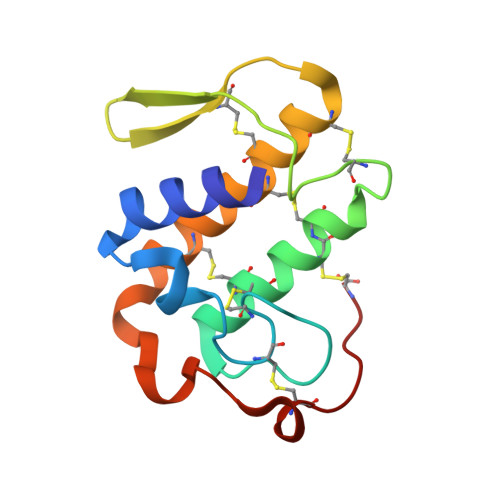Crystal structures of the complexes of a group IIA phospholipase A2 with two natural anti-inflammatory agents, anisic acid, and atropine reveal a similar mode of binding
Singh, N., Jabeen, T., Pal, A., Sharma, S., Perbandt, M., Betzel, C., Singh, T.P.(2006) Proteins 64: 89-100
- PubMed: 16596639
- DOI: https://doi.org/10.1002/prot.20970
- Primary Citation of Related Structures:
1SV3, 2ARM - PubMed Abstract:
Secretory low molecular weight phospholipase A(2)s (PLA(2)s) are believed to be involved in the release of arachidonic acid, a precursor for the biosynthesis of pro-inflammatory eicosanoids. Therefore, the specific inhibitors of these enzymes may act as potent anti-inflammatory agents. Similarly, the compounds with known anti-inflammatory properties should act as specific inhibitors. Two plant compounds, (a) anisic acid (4-methoxy benzoic acid) and (b) atropine (8-methyl-8-azabicyclo oct-3-hydroxy-2-phenylpropanoate), have been used in various inflammatory disorders. Both compounds (a) and (b) have been found to inhibit PLA(2) activity having binding constants of 4.5 x 10(-5) M and 2.1 x 10(-8) M, respectively. A group IIA PLA(2) was isolated and purified from the venom of Daboia russelli pulchella (DRP) and its complexes were made with anisic acid and atropine. The crystal structures of the two complexes (i) and (ii) of PLA(2) with compounds (a) and (b) have been determined at 1.3 and 1.2 A resolutions, respectively. The high-quality observed electron densities for the two compounds allowed the accurate determinations of their atomic positions. The structures revealed that these compounds bound to the enzyme at the substrate - binding cleft and their positions were stabilized by networks of hydrogen bonds and hydrophobic interactions. The most characteristic interactions involving Asp 49 and His 48 were clearly observed in both complexes, although the residues that formed hydrophobic interactions with these compounds were not identical because their positions did not exactly superimpose in the large substrate-binding hydrophobic channel. Owing to a relatively small size, the structure of anisic acid did not alter upon binding to PLA(2), while that of atropine changed significantly when compared with its native crystal structure. The conformation of the protein also did not show notable changes upon the bindings of these ligands. The mode of binding of anisic acid to the present group II PLA(2) is almost identical to its binding with bovine pancreatic PLA(2) of group I. On the other hand, the binding of atropine to PLA(2) is similar to that of another plant alkaloid aristolochic acid.
Organizational Affiliation:
Department of Biophysics, All India Institute of Medical Sciences, New Delhi, India.


















